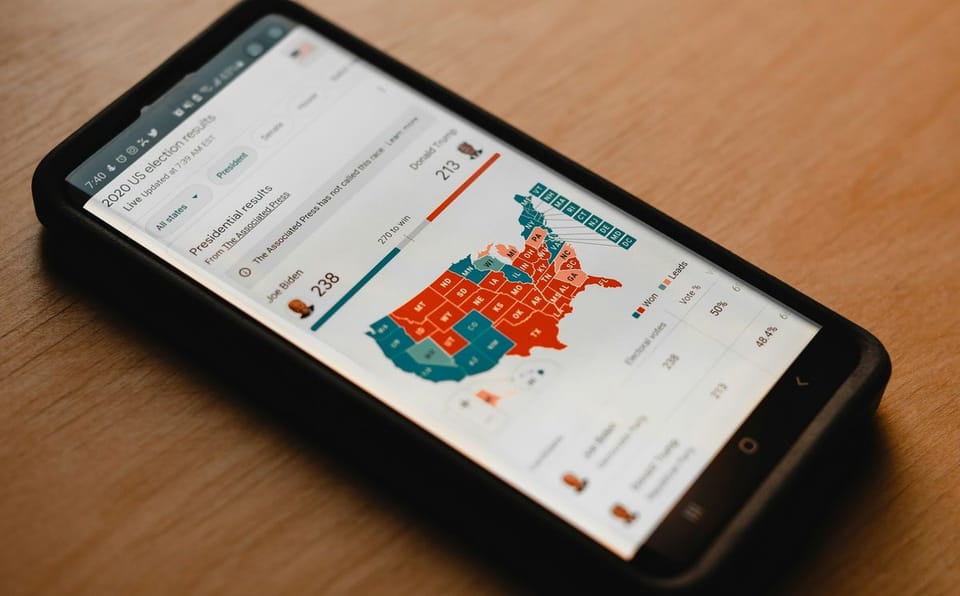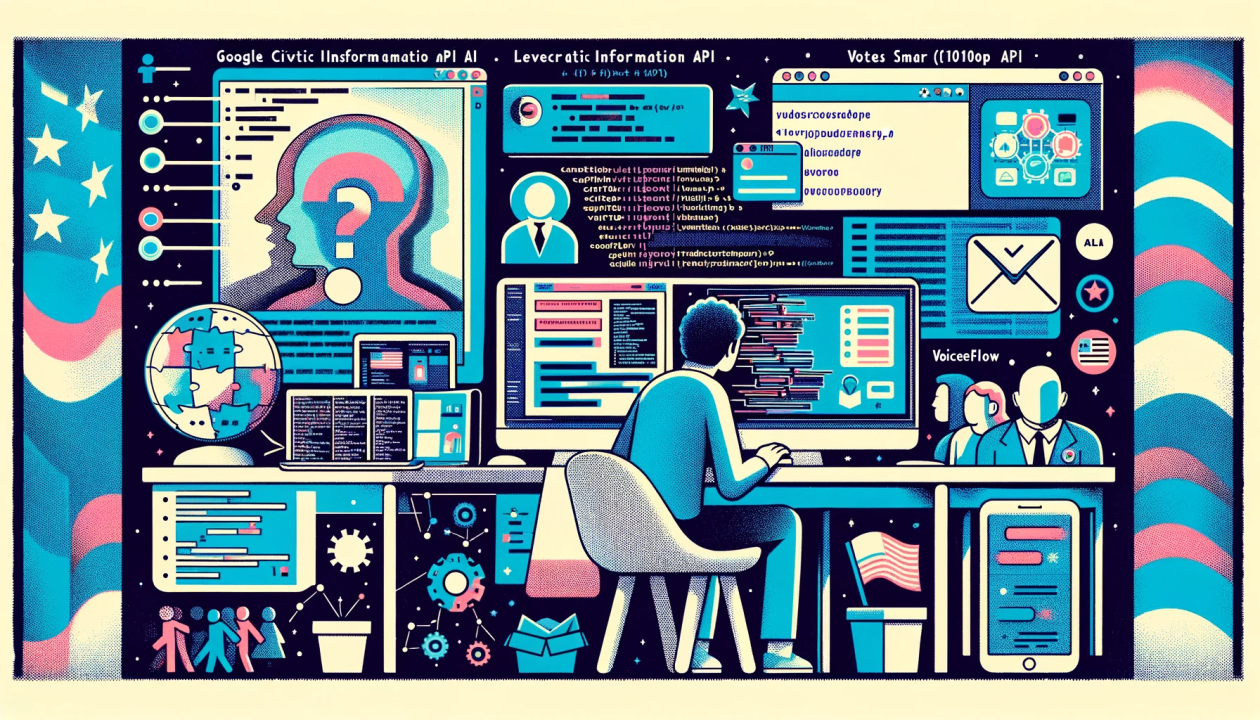The Role of AI Chatbots in Enhancing Voter Participation: Insights from a Recent Study

In the digital age, the intersection of artificial intelligence (AI) and civic engagement is increasingly becoming a focal point for both technological innovation and societal change. The recent study "On Safe and Usable Chatbots for Promoting Voter Participation" by Bharath Muppasani and colleagues at the AI Institute, University of South Carolina, USA, significantly contributes to this evolving landscape.
This study explores the potential of chatbots to increase voter participation among vulnerable segments of society, such as senior citizens and first-time voters, by amplifying official information while personalizing it to users' unique needs transparently, including language, cognitive abilities, and linguistic abilities. Parallel to this academic research, my project aims to harness the capabilities of Large Language Models (LLMs), APIs, and Python to create an informative election-focused chatbot.

This initiative is not only a step towards achieving my personal goal of enhancing my technical skills but also aims to address a significant societal need. By developing a prototype using ChatGPT's custom GPTs, I am laying the groundwork for understanding the intricacies of AI-driven chatbot development before transitioning to using Botpress for the final product. This project builds upon my previous work, such as the Congress Explorer, which employed ProPublica's API to educate users about congressional activities.
Background and Motivation
The success of any democracy hinges on the active participation of its citizens in the electoral process. Traditionally, voting has been seen as the preeminent indicator of political participation. However, the complexity of voting processes in various states can act as a deterrent to potential voters. The study specifically focuses on Mississippi and South Carolina, ranked as the 2nd and 8th most complex states for citizens to vote in, according to the Cost of Voting Index (COVI). This complexity underscores the need for innovative solutions to facilitate easier access to voting information and processes.
The Promise of AI in Civic Engagement
AI, particularly in the form of chatbots, offers a promising avenue for enhancing civic engagement. Chatbots, as multi-modal collaborative assistants, can provide voters with easy access to information about voting dates, jurisdiction, locations, and issues on the ballot in their language or words through smartphones, computers, and home devices like Alexa. This accessibility is crucial for overcoming the barriers posed by the complexity of voting processes and guaranteeing that all citizens, regardless of their technological expertise, can participate fully in the democratic process.
The potential benefits of employing AI in elections include:
- Increased Accessibility: By providing voting information in various languages and formats, chatbots can make voting more accessible to a broader range of voters, including those with disabilities or limited English proficiency1.
- Enhanced Voter Participation: By demystifying the voting process and making information more readily available, chatbots can increase voter turnout, especially among populations that might otherwise feel excluded or overwhelmed by the voting process1.
- Reduction in Misinformation: With a design that responses that are grounded and traceable to official sources, these chatbots can serve as a reliable source of information, countering the spread of misinformation related to elections1.
The Perils of AI in Elections
Despite the promising applications of AI in enhancing democratic participation, there are significant concerns associated with its use in elections:
- Misinformation and Hacking: The fear that AI could be used to disseminate misinformation or be susceptible to hacking is a major concern. Misinformation can skew public perception and influence election outcomes while hacking threatens the integrity of the electoral process1.
- Bias and Privacy Concerns: AI systems, including chatbots, can inadvertently perpetuate biases in their training data, leading to unequal access to information. Privacy concerns also arise from the potential misuse of personal data collected through interactions with chatbots1.
- Dependence on Technology: There's a risk that reliance on AI for election information could alienate voters who are uncomfortable with or do not have access to technology, widening the digital divide.
Innovations in Chatbot Design
The study outlines a general architecture for building chatbots that prioritize safety and usability. This includes a database of verified questions and answers, an intent generator to understand user queries, a paraphraser to handle varied user inputs, and a response generator to communicate with users effectively. Additionally, the system integrates common services for accessibility, such as text-to-speech and language settings, and employs a "do-not-answer" option for inappropriate questions1.
The study introduces several innovative features in chatbot design aimed at promoting voter participation:
- Safe Design: The chatbots are designed to provide only grounded and traceable responses to an allowed source, such as official question/answer pairs from government websites. This ensures the reliability of the information provided and addresses concerns about misinformation1.
- Do-Not-Respond Strategy: To further safeguard against the dissemination of misinformation, the chatbots employ a do-not-respond strategy that allows for customizable responses or deflection when faced with misleading questions.
- Low-Programming Design: Employing the open-source Rasa platform, the chatbots can be quickly generated for any region, making this solution highly scalable and adaptable to different electoral contexts1.
Application and Evaluation
The prototypes developed for Mississippi and South Carolina were evaluated using focus groups with senior citizens, demonstrating the chatbots' potential to serve as valuable tools for election agencies and democracy. These evaluations highlighted the importance of providing information on election procedures, absentee ballots, and the operation of election equipment, among other topics.
The thesis "On Safe and Usable Chatbots for Promoting Voter Participation" by Bharath Muppasani and colleagues introduces several innovative design features to enhance voter engagement through chatbots. These innovations focus on ensuring the safety, usability, and rapid deployment of chatbots for voter information dissemination. Here, we delve into these innovations with more detail and data, especially focusing on their application in South Carolina and Mississippi.
Application in South Carolina
In South Carolina, the chatbot was designed to address a wide range of topics related to the voting process. The state's official website provided 30 FAQs covering 10 different topics with an average question length of 10.9 words and an average answer length of 80.9 words. The topics included:
- Voting information
- Candidature information
- Absentee voting
- Polling information
- Ballot information
- Campaign
- Polling results
- Recounting
- Complaints
- General information
For example, one of the questions addressed by the chatbot is about the connectivity of the voting system to the internet, with the chatbot clarifying that the voting system is never connected to the internet, ensuring the security of the voting process. Another question pertains to the legality of ballot selfies, with the chatbot explaining that state law prohibits showing one's ballot to another person, emphasizing the privacy of the voting process.
Application in Mississippi
The chatbot for Mississippi was developed to address a narrower range of topics, with the official website providing 12 FAQs covering 5 topics. The average question length was 7.75 words, and the average answer length was 119.5 words. The topics included:
- Absentee voting
- Voter registration
- Voting
- Information update
- Candidature information
One of the questions tackled by the chatbot involves casting a vote, with the chatbot informing users that their Voter Registration Card will provide all necessary details about their voting precinct. Another question focuses on checking if one is registered to vote, with the chatbot directing users to verify their registration status online.
Safe Design
The chatbots are designed with a foundational emphasis on safety, ensuring that all user responses are grounded in official sources. This is achieved through a system's self-awareness (metacognition), where the chatbot can trace its responses back to an allowed source, such as official question/answer pairs from government websites. This design principle addresses concerns about misinformation by ensuring that the chatbot only disseminates verified information1.
Do-Not-Respond Strategy
To further enhance safety and prevent the spread of misinformation, the chatbots employ a "do-not-respond" strategy. This allows the chatbot to deflect or customize responses when faced with questions that could lead to the dissemination of unverified or misleading information. This strategy is crucial in maintaining the integrity of the information provided, especially in the sensitive context of elections where misinformation can have significant consequences1.
Low-Programming Design
The chatbots are built on the open-source Rasa platform, which enables a low-programming design pattern. This approach allows for the quick generation of chatbots for any region, making the solution highly scalable. Using Rasa also facilitates the integration of common conversation utterances and accessibility features, such as speech recognition, enhancing the usability of the chatbots across different user demographics.
Future Directions and Conclusion
The study concludes that AI chatbots can significantly enhance voter participation by providing safe, personalized, and accessible information. Future work could extend the chatbots' capabilities, evaluate their impact in more states, and explore multi-modal interactions to engage a broader audience. In summary, the research by Muppasani and colleagues offers valuable insights into the potential of AI chatbots to democratize information access and encourage voter participation. By addressing the challenges of misinformation and accessibility, these chatbots could significantly contribute to the vitality of democratic processes.
The study outlines several avenues for future research and development that could further the impact of chatbots in the electoral process:
- Extending Information Range: One of the primary future directions involves broadening the scope of information that chatbots can provide. This includes procedural details about voting and information about candidates, propositions, and measures on the ballot. Chatbots could become a one-stop source for all election-related queries1 by offering a more comprehensive information service.
- Expansion to More States: The current study focused on South Carolina and Mississippi, known for their complex voting processes. Expanding the development and deployment of these chatbots to more states, especially those with varying degrees of voting complexity, could provide insights into the scalability and adaptability of the chatbot framework. This expansion would also allow for a broader assessment of the chatbot's effectiveness across different demographic and geographic contexts1.
- Enhancing Multi-Modal Capabilities: Another promising direction is the enhancement of the chatbots' multi-modal capabilities. This could involve integrating voice recognition and response functionalities, making the chatbots accessible through smartphones and smart speakers. Such capabilities would cater to users with different preferences and make the chatbots more accessible to individuals with disabilities, such as visual impairments1.
- Evaluating Impact Through Randomized Controlled Trials (RCTs): The study suggests rigorously using RCTs to evaluate chatbots' impact on voter participation. By comparing the effectiveness of chatbots against control groups, researchers can obtain empirical evidence on their utility in increasing voter engagement and participation. Such studies could also explore the chatbots' effectiveness in reducing misinformation and enhancing the overall voting experience1.
Conclusion
The research conducted by Muppasani and colleagues represents a significant step forward in leveraging AI to support democratic processes. By focusing on developing safe, usable, and scalable chatbot systems, the study highlights the potential of technology to make voting more accessible and less daunting for all citizens, particularly those who might face barriers to participation. As the study concludes, there is a clear path forward for expanding the capabilities and reach of these chatbots, with the ultimate goal of enhancing voter participation and strengthening democracy.
The future directions outlined in the study provide a roadmap for further research and underscore the transformative potential of AI in civic engagement. The implications of this work are profound, suggesting that AI can indeed play a positive role in driving voter participation. As the study moves into future phases, the continued development and evaluation of these chatbot systems will be crucial in realizing their full potential to support voters and enrich the democratic process.